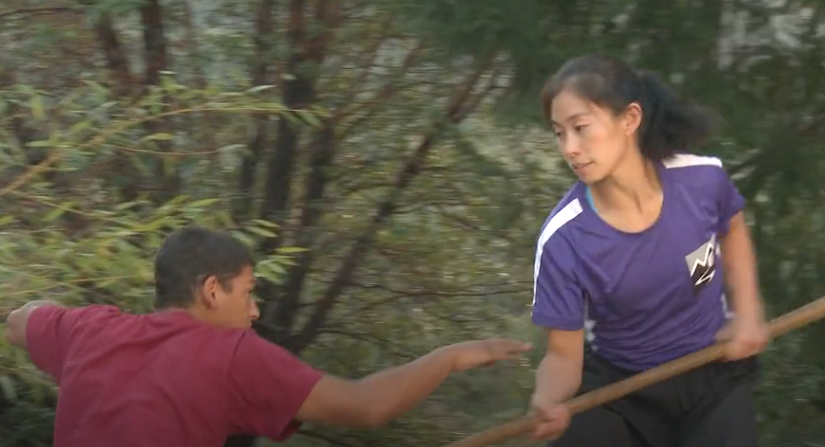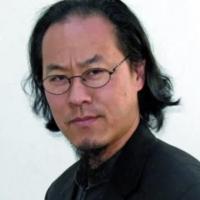Preserving traditional kung fu is a mounting challenge. For proponents of such time-honored lineages, the decline of the classical arts is a persistent grievance, even more so nowadays, or so it seems. The modern world is accelerating. Ever-shortening attention spans no longer support the immense time on task required to become even passingly competent in traditional kung fu. Nowadays, it's hard enough just to preserve good basics, let alone the sophisticated requirements of mastery. Given the vast scope of traditional kung fu, so many aspects seem to be falling to the wayside. Obscure styles, exotic and unusual weapons, and forms that require multiple participants are fading from practice.
Recently, I interviewed Michelle Lin and Quentin Lopes for a YMAA Meet the Author video about their new streaming program Barehand vs Staff: Shaolin White Crane Kung Fu Sequence. Both are products of Dr. Yang's aspirational retreat center. They devoted years of their lives to study and practice in solitude. They took more time than most of us can afford to allocate to kung fu. And now, with this new instructional video, they are working to preserve a very special form of the YMAA curriculum.
Our discussion of Barehand vs Staff got me reminiscing over all the two-person sequences I learned in my youth. We called them sparring sets at my school. The bulk of the sparring sets that I learned were from Northern Shaolin, which is a parallel lineage to Dr. Yang's. One of his forebearers was Hán, Chìng-Táng (韓慶堂 1903-1976) a graduate of the Nanjing Central Guoshu Institute. My great grandmaster was Gù Rǔzhāng (顾汝章 1894-1952) who was also part of the Guoshu Institute. Beyond my Northern Shaolin practice, I picked up a few other sparring sets along the way, such as ānshēnpào from Xìngyì Quán (see Xingyiquan-Theory, Applications, Fighting Tactics, and Spirit 2nd ed. by Liang, Shou-Yu & Dr. Yang, Jwing-Ming). I even learned a three-person staff sparring form. But that was several decades ago.
Paired Practice
Today sparring sets (or two-person sequences) are commonly called duìliàn (对练). This literally means 'paired practice.' Duìliàn is a part of both traditional kung fu and modern sport wushu. Say what you may about modern sport wushu, but their duìliàn is absolutely thrilling. The speed and precision of competitive wushu duìliàn is always a showstopper. I've long argued that solo sport wushu should not have been submitted as a potential Olympic event for the past few decades. It should've been wushu duìliàn. Judging it would have been closer to paired figure skating than gymnastics – a test of skill and coordination with a partner. For the uninitiated, something like solo wushu taijiquan is tough to comprehend. But everyone gets a good fight scene and that's exactly what wushu duìliàn delivers.
It's also why kung fu movies outnumber every other style of martial arts movies combined. We've got great fight scenes. Sure, there's The Karate Kid, but can you name another dozen karate films? How about a dozen taekwondo or MMA films? Any fan of the genre could name dozens of kung fu films with ease. Super fans can even name a dozen films with just 'Shaolin' in the title. This is largely due to the power of duìliàn. While many styles of martial arts have sparring sets, few are on the same level of sophistication as the Chinese styles. Beyond practical applications of combat techniques, duìliàn has a certain style and flair that makes it more appealing for cinematic fight choreography. Some of this descends from an unlikely source – traditional Chinese opera.
Traditional Chinese Opera
The influence of Chinese opera upon Chinese martial arts cannot be discounted. Different from European opera, Chinese opera divided into two categories: wén (文) and wǔ (武). Wǔ operas depict great battles of history and legend, and the martial arts demonstrations within these are spectacular displays of skill. This influenced the theatricality of duìliàn, not only in the flamboyant moves embedded in many two-person sequences, but also in the most influential cadre of martial actors. Jackie Chan, Sammo Hung, Yuen Woo-Ping, Corey Yuen, Yuen Biao, and Yuen Wah are all martial brothers who were trained in opera style from childhood under Yu Jim-yuen (as his pupils, they all adopted the Yuen part of his name as their stage names – previously Jackie was Yuen Lau and Sammo was Yuen Lung). What's more, Bruce Lee's father, Lee Hoi-chuen, was an opera singer who surely influenced the Little Dragon's unique acting style.
Styles of Two-Person Sequences
There are three types of two-person sequences: empty hand vs empty hand, empty hand vs weapon, and weapon vs weapon. While empty hand vs empty hand sequences generally provide equal practice for either side, the second two types favor one over the other. When one side has the advantage, it is the underdog that is being trained more. With weapon vs weapon sets, the spear is the most common adversary, such as spear vs staff, spear vs sword, and spear vs guandao. In the Chinese martial arts, the spear is known as 'the King of weapons' because of its simplicity and effectiveness, making it the perfect choice as the ultimate cold arm adversary. It is the weapon that opposes the spear that is being trained.
Weapon vs weapon sets are a critical steppingstone to understanding the more exotic weapons. When I learned spear vs three-section staff, it unlocked so much of my understanding of that unwieldy weapon. Prior to learning that, I was more afraid of hitting myself with a three-section staff. Spear vs three-section staff dramatically increased my understanding of how that weapon works. Now when I pick up some triple-sticks, it's the adversary who should be afraid, and rightly so.
In empty hand vs weapon sequences, obviously the weapon wielder has the advantage so it's the empty hand practitioner that is being trained. YMAA's Barehand vs Staff is surprisingly unique. While it might seem to be a rudimentary form, only a few kung fu systems have anything like this within their curriculum. The Northern Shaolin system that I learned didn't have it. The only empty hand vs weapon sequence we had was empty hand vs double daggers. These empty hand vs weapon sets are akin to the unarmed vs weapon training sequences trained by almost every self-defense system. However, instead of single combat applications, empty hand vs weapon sequences are extremely complex, linking several applications together to challenge the unarmed practitioner to respond with a rapid succession of defenses.
Despite the practical training and the cinematic spotlight, duìliàn is one of the most vulnerable traditions of Chinese martial arts. All traditional Chinese martial arts are difficult to preserve because they are difficult to master. There's attrition for most masters as they try to pass them down to their students. Duìliàn faces an additional obstacle. It takes two to tango. Without two practitioners of equal commitment, a two-person sequence won't be retained. When your sparring set partner moves on, they take half the form with them. I've separated from every one of my sparring set partners years ago, so I haven't been able to practice them. Consequently, I must confess that I've forgotten every sparring set I ever learned.
We live in the luxury of the video age when every aspect of traditional kung fu can be recorded. However, even though it is documented, it can still disappear. We have images of the dodo bird, but it's still extinct. The video is just an architectural blueprint; it's not the building itself. More important than the recording is the practice. If sparring sets like what Michelle and Quentin have captured with Barehand vs Staff: Shaolin White Crane Kung Fu Sequence aren't practiced, it fades into a snapshot of what was, not what is. It becomes another lost treasure of days gone by.
We all romanticize about the good old days of kung fu. If you bemoan the loss of those old school ways, this burden of preservation falls into your lap. You cannot complain about lost arts if you don't practice. Some of us, like Michelle and Quentin, are doing the work. For traditional arts to survive, we all must do our part to support them.
The above is an original article by Gene Ching, Staff Writer for YMAA Publication Center.



